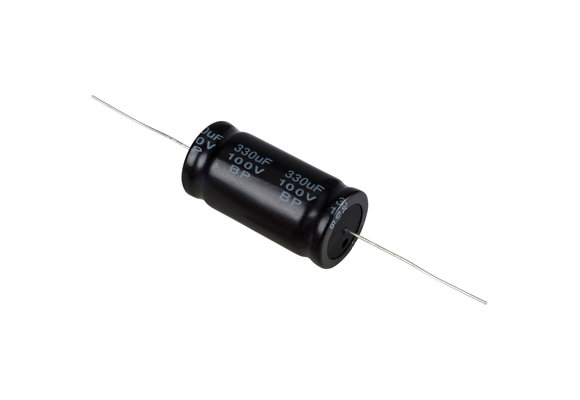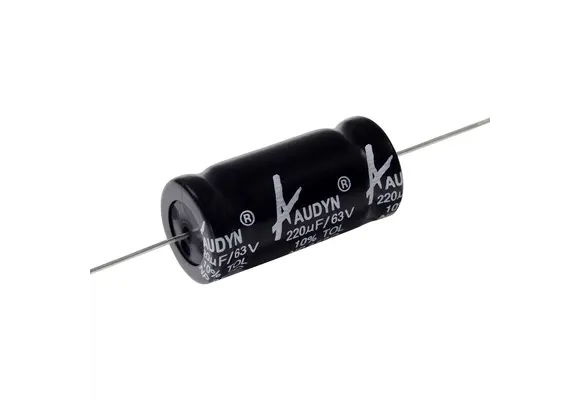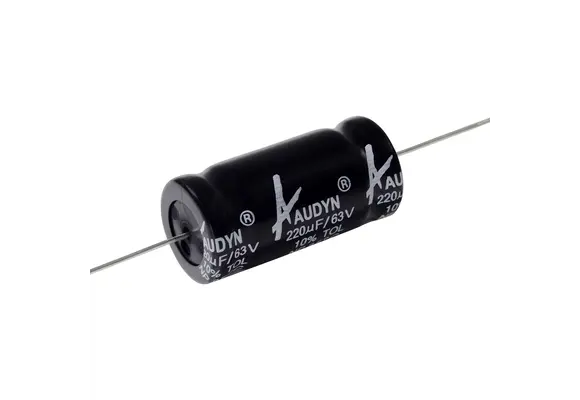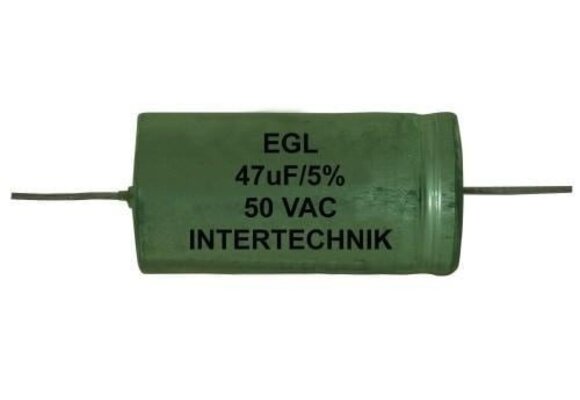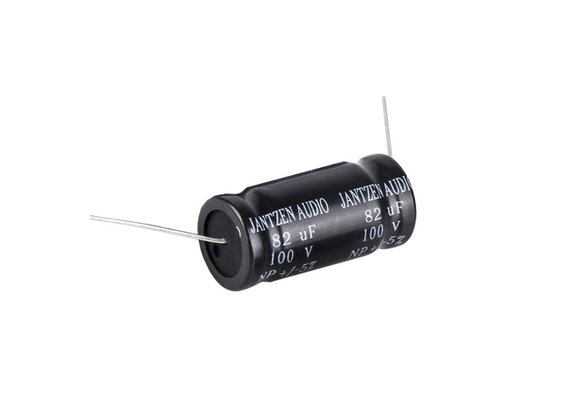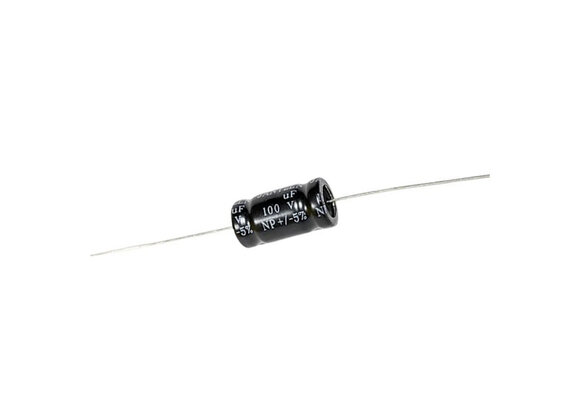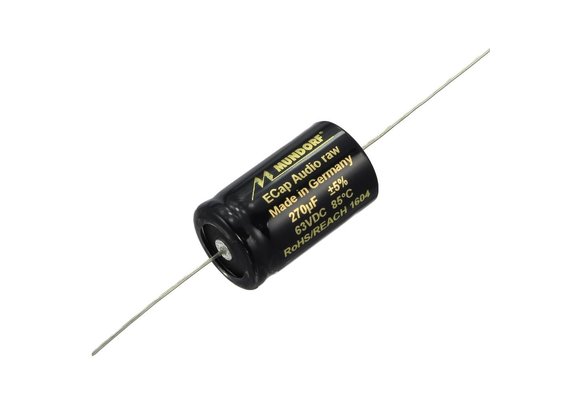What is an electrolytic capacitor?
Non-polarized electrolytic capacitors have foils with surfaces roughened by a unique etching process, enlarging the surface. This enables it to have a much higher capacitance than other more straightforward types. The electrolytic capacitors offered by SoundImports are all non-polarised and are available with values from 1 to 4700 uF. The non-polarized electrolytic capacitors offered by SoundImports handle high working voltage from up to 100V. They are useful in places where a high ripple current is needed, such as power supplies. As the capacity of capacitors is proportional to their surface, this process provides the smallest and cheapest type of capacitors. However, this process also weakens the sound quality comparing to non-etched versions. Overall, an electrolytic capacitor is a good type of capacitor. They are perfect for using it in a crossover and ideal for a low-budget project! However, if you are looking for higher quality, feel free to check out our film/foil capacitors!
Here at SoundImports, you can buy non-polarized electrolytic capacitors from Jantzen Audio and Mundorf!
What are the advantages and disadvantages of an electrolytic capacitor?
Tantalum capacitors are the most common type of electrolytic capacitor. Others are classified according to the dielectric paste or the type of gas used. Aluminium electrolytic and polypyrene are common. In any case, the capacitance of an electrolytic capacitor could only be matched by a much larger non-electrolytic capacitor (such as paper or mica capacitors). Therefore, their size is considered one of the main advantages.
Electrolytic capacitors need more care than other capacitors due to their construction and polarity-sensitive operation. Electrolytic capacitors built incorrectly (reverse polarised) will not achieve the correct capacitance and can create internal gas pressure, resulting in a (minor) explosion. Electrolytic capacitors are often more sensitive to temperature than other capacitor types. Therefore, their sensitivity is considered one of their main disadvantages.
How does an electrolytic capacitor work?
Electrolytic capacitors, like most typical capacitors, store electric energy statically by charging isolation in an electric field between two electrodes in the dielectric oxide layer. The cathode, which serves as the capacitor's second electrode, comprises a non-solid or solid electrolyte.
What is the difference between an electrolytic capacitor and a film/foil capacitor?
The main distinction between an electrolytic capacitor and a film/foil capacitor can be traced back to the type and construction of the dielectric used. Although the active component of electrolytic capacitors comprises aluminium (anode and cathode foil), paper, and electrolyte, the film/foil capacitor is constructed of metal-coated plastic film that forms the electrodes. Active electrolytic aluminium capacitors have an energy density up to ten times greater than polypropylene film capacitors. The non-polarized electrolytic capacitors here at SoundImports are the best low-cost solutions for passive speaker crossovers!

 Home audio
Home audio  Audio components
Audio components  Crossover components
Crossover components  Test & measurement
Test & measurement  DIY kits
DIY kits  Accessories
Accessories  New products
New products  Speakers
Speakers Amplifiers
Amplifiers DAC converters
DAC converters DSP modules
DSP modules Turntables
Turntables Streamers
Streamers Woofers
Woofers Tweeters
Tweeters Exciters
Exciters Bass shakers
Bass shakers Plate amplifiers
Plate amplifiers Amplifier modules
Amplifier modules Single board computers
Single board computers Assembled crossovers
Assembled crossovers Printed Circuit Boards (PCB)
Printed Circuit Boards (PCB) Capacitors
Capacitors Resistors
Resistors Coils
Coils Circuit Breakers
Circuit Breakers Crossover tools
Crossover tools Screw terminals
Screw terminals Acoustic measurements
Acoustic measurements Electric measurements
Electric measurements Sound level meters
Sound level meters DIY amplifier kits
DIY amplifier kits DIY component packs
DIY component packs DIY speaker kit
DIY speaker kit DIY subwoofer kits
DIY subwoofer kits DIY bluetooth speaker
DIY bluetooth speaker DIY electronics kits
DIY electronics kits Binding posts
Binding posts Cabinet Hardware
Cabinet Hardware Cables
Cables Connectors
Connectors Speaker cabinets
Speaker cabinets Electromechanics
Electromechanics Power supplies
Power supplies Speaker repair
Speaker repair Workshop & tools
Workshop & tools Amplifier accessories
Amplifier accessories Stands & mounts
Stands & mounts Gift voucher
Gift voucher Books
Books New products
New products









 Speakers
Speakers Amplifiers
Amplifiers DAC converters
DAC converters DSP modules
DSP modules Turntables
Turntables Streamers
Streamers Woofers
Woofers Tweeters
Tweeters Exciters
Exciters Bass shakers
Bass shakers Plate amplifiers
Plate amplifiers Amplifier modules
Amplifier modules Single board computers
Single board computers Assembled crossovers
Assembled crossovers Printed Circuit Boards (PCB)
Printed Circuit Boards (PCB) Capacitors
Capacitors Resistors
Resistors Coils
Coils Circuit Breakers
Circuit Breakers Crossover tools
Crossover tools Screw terminals
Screw terminals Acoustic measurements
Acoustic measurements Electric measurements
Electric measurements Sound level meters
Sound level meters DIY amplifier kits
DIY amplifier kits DIY component packs
DIY component packs DIY speaker kit
DIY speaker kit DIY subwoofer kits
DIY subwoofer kits DIY bluetooth speaker
DIY bluetooth speaker DIY electronics kits
DIY electronics kits Binding posts
Binding posts Cabinet Hardware
Cabinet Hardware Cables
Cables Connectors
Connectors Speaker cabinets
Speaker cabinets Electromechanics
Electromechanics Power supplies
Power supplies Speaker repair
Speaker repair Workshop & tools
Workshop & tools Amplifier accessories
Amplifier accessories Stands & mounts
Stands & mounts Gift voucher
Gift voucher Books
Books New products
New products
